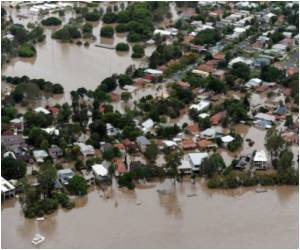Jakarta has launched a multi-billion-dollar scheme to build a huge sea wall to combat flooding as the Indonesian capital sinks.

The 35-kilometre (22-mile) wall, across the Bay of Jakarta off the city's northern coast, is the centrepiece of a project that will cost up to $40 billion over three decades, and also includes reclaiming land for 17 new islands.
The whole project will form the shape of a Garuda, the mythical bird that is Indonesia's national symbol.
While the aim is to prevent floods, it is hoped up to one million people will live and work on the islands, and help take pressure off a crowded city notorious as one of the world's most uninviting urban sprawls.
Supporters of the project, which officially got under way last week and is run by the Indonesian government with help from Dutch experts, say it is the only long-term solution.
"It's a life-and-death situation," said Purba Robert M. Sianipar, a senior economics ministry official with a key role in the project, adding hundreds were at risk of losing their lives from severe flooding if action was not taken.
Advertisement
Chief Economics Minister Chairul Tanjung suggested as much at last week's launch event, saying disagreements with future governments could knock the project off schedule.
Advertisement
Jakarta has long been hit by floods during the rainy season, when tropical downpours cause rivers to burst their banks and deluge inadequate drainage systems, forcing tens of thousands out of their homes.
However in 2007, a new type of flood set alarm bells ringing.
- Rivers could stop flowing -
Slum neighbourhoods were inundated when a high tide surged over sea defences in northern Jakarta, something that had never happened before and which highlighted the severe land subsidence in many areas.
As Jakarta has rapidly grown to a population of about 10 million, increased water extraction for drinking has caused the ground to compact and parts of the city to sink, a problem seen in other coastal conurbations, such as Ho Chi Minh City and Bangkok.
Parts of coastal north Jakarta, which is built on soft clay, are sinking as fast as 14 centimetres (5.5 inches) a year, meaning they could be metres below sea level in a few decades, according to those behind the sea wall project.
"Basically we are pumping ourselves into the ground," said Victor Coenen, from Dutch consultants Witteveen and Bos, which devised the master plan for the project.
The subsidence also means the 13 rivers in Jakarta may sink below sea level and stop flowing, increasing the risk of inundations.
After the 2007 floods -- which forced hundreds of thousands out of their homes -- officials scrambled to come up with a plan.
It involves strengthening the current, low sea defences over the next few years to provide temporary protection for north Jakarta, home to more than four million people.
Work will then begin on the main wall, which will sit six to eight kilometres (four to five miles) from the coast and will be seven metres (23 feet) above sea level.
Construction of the wall will be finished between 2025 and 2030, while development on the islands -- which will have a mix of high-end and low-cost housing -- could take another decade.
A huge reservoir will be created between the islands and sea wall, where water from downpours can be stored so it does not flood the city, and into which rivers will be able to flow freely.
Plans are also in progress to slow the land subsidence by providing piped water to Jakarta from other areas and stop extraction of ground water.
Source-AFP









